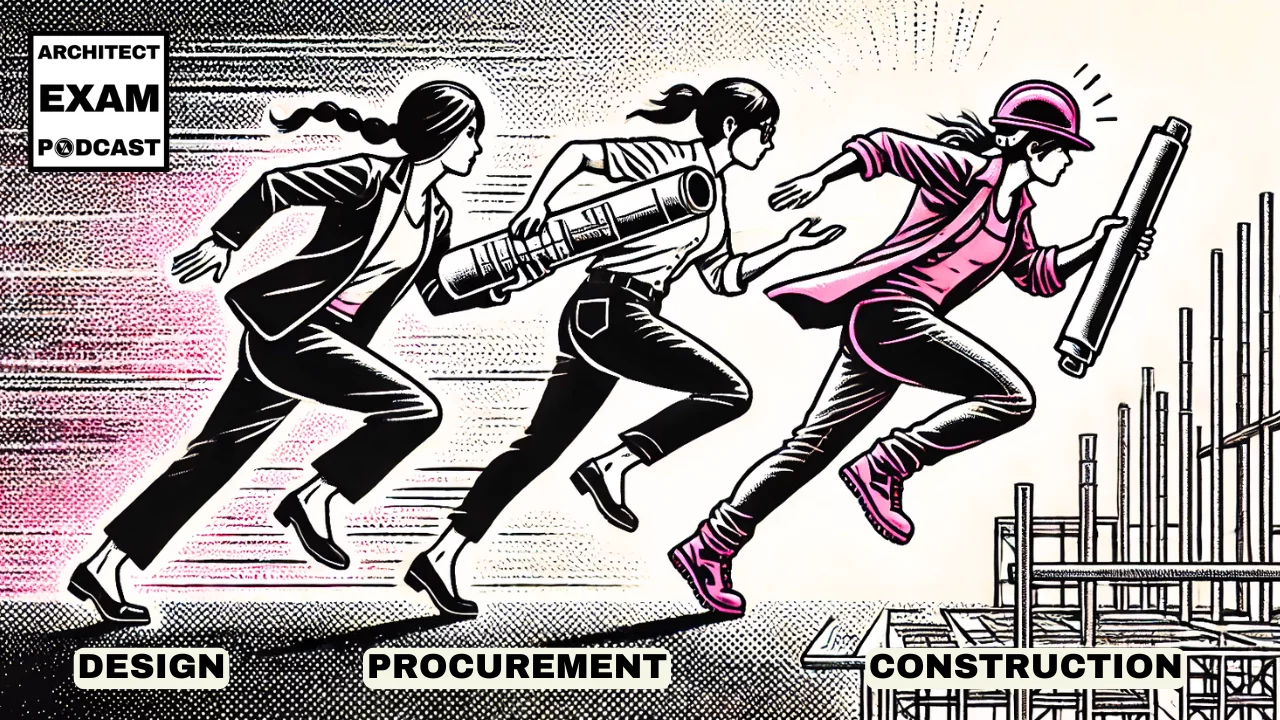Navigating the construction bidding process is essential for all AEC professionals working on public projects. This comprehensive guide breaks down the procurement journey from design completion to groundbreaking, demystifying the rules, timelines, and requirements that often confuse those without public project experience.
This podcast is also available on YouTube, Spotify, and Apple Podcasts
The Black Box Between Design and Construction
Have you ever wondered what happens after architectural drawings are completed, but before construction actually begins? For many architects and design professionals, especially those who have worked primarily on private or residential projects, the public bidding process remains a mysterious “black box.”
I’ve had the unique opportunity to see this process from both sides – first as an architect working on public projects, and later as a government project manager responsible for hiring architects, contractors, and engineers. This dual perspective helped me understand the full procurement journey and the reasoning behind its many rules and requirements.
In a previous article about public vs. private architecture clients, we discussed how your client type dramatically changes project dynamics. The bidding process in construction is perhaps where these differences are most apparent.
This knowledge matters for three key groups:
- ARE candidates preparing for exams (particularly the Construction & Evaluation division)
- AEC professionals new to public projects
- Experienced professionals transitioning from private/residential work
The culture shock can be intense when moving from private to public work. What once was accomplished with a phone call and a handshake now involves formal advertisements, strict deadlines, public bid openings, and enough paperwork to wallpaper your entire office – twice. Let’s demystify how the bidding process works together.
Design-Bid-Build Timeline
Let’s start with what everyone wants to know: how long will this take? While every project is different, the typical public project using the Design-Bid-Build delivery method takes approximately 2-3 months from completed drawings to breaking ground. Larger projects can take considerably longer.
Here’s the general timeline breakdown for the construction procurement process:
- Bid document preparation: 2-4 weeks
- Advertising and bidding period: 3-6 weeks
- Evaluation and award: 1-2 weeks
- Contract signing and pre-construction: 1-3 weeks
Throughout this process, several key players work together:
- The owner’s procurement department acts as the legal gatekeepers of the process
- Owner’s project managers oversee the technical aspects
- Design professionals provide clarifications during bidding
- Contractors and subcontractors prepare and submit contractor bids
- Oversight bodies like city councils provide final approvals
Most people don’t fully understand the critical role of the procurement department. These specialists in contracting law ensure the government procurement process follows all legal requirements. Think of them as the construction world’s equivalent of baseball umpires – they don’t play the game, but they make sure everyone follows the rules, and nobody’s particularly happy to see them until they need a call in their favor. They maintain fairness, prevent favoritism, and make sure taxpayer money is spent properly. They handle advertisements, receive bids, and enforce all bidding rules.
This entire process is governed by laws and regulations like the Federal Acquisition Regulation for federal projects or state-specific procurement codes designed to ensure:
- Fairness – giving all qualified contractors an equal chance
- Transparency – making the process open to public scrutiny
- Accountability – ensuring proper use of public funds
- Competition – obtaining the best value for taxpayer dollars
Now let’s explore each stage of this construction bid process in detail.
8 Key Stages of the Public Construction Bidding Process
1. Bid Preparation
Once architectural drawings are complete, they need to be transformed into comprehensive bidding documents. This transformation involves several critical steps:
- The procurement department adds legal front-end documents and bonding requirements
- The design team finalizes technical specifications which are essential for proper bidding
- Understanding the differences between construction specification types is critical for preparing comprehensive bidding documents
- The project may be divided into a base bid with alternates to provide budget flexibility
This preparation phase is crucial because poorly detailed documents create opportunities for contractors to find ambiguities. Understanding the relationship between drawings and specifications is essential for creating clear, comprehensive documents that help prevent low initial bids followed by expensive change orders during construction.
A well-organized construction bid package example might include the invitation to bid for construction projects, technical specifications, drawing sets, addenda forms, and a detailed bid schedule that outlines key milestones.
2. Advertisement
With bid documents prepared, the project must be advertised to potential bidders. Different levels of government use different methods to announce government construction projects for bid:
- Federal projects are posted on SAM.gov
- State projects use state procurement websites
- Local projects appear in official newspapers, city websites, and plan rooms
These advertisements must include specific information like project descriptions, submission deadlines, document access instructions, bond requirements, and pre-bid meeting details. This stage is what starts the bidding process officially.
Time periods for advertisements are strictly regulated by law. Federal projects typically require at least 30 days of advertising, while states often mandate 3-4 weeks minimum to ensure fairness.
3. Bidding Period
During the bidding period, a pre-bid meeting is typically held. This crucial gathering brings together contractors, the owner, architect, subcontractors, and suppliers. It allows contractors to see the site, meet the team, and ask questions before finalizing their bids.
As questions arise during the bidding period, a formal process must be followed:
- Questions are submitted to the procurement official, not directly to the architect
- The architect cannot share information unless it goes through procurement
- When clarifications are needed, formal addenda are issued to modify the bid documents
Most jurisdictions prohibit issuing addenda within 72 hours of bid opening without extending the deadline. This gives bidders adequate time to finalize their prices and prevents last-minute changes that could disadvantage some bidders.
Many contractors wait until all addenda have been issued before seriously preparing their construction bids to avoid rework. During this time, general contractors also collect subcontractor bids for various trade packages.
4. Bid Submission & Opening
When bid day arrives, the rules are strict and unforgiving:
- Bids must be sealed and include bid security (usually 5-10% of the bid amount)
- Submissions must arrive before the deadline – even one minute late can disqualify a bid
- There are no exceptions or grace periods – in the public bidding world, ‘fashionably late’ isn’t a concept – it’s more like ‘permanently disqualified’
The bid opening is a public event where procurement officials open each sealed submission, reading aloud the bidder’s name and total price. Anyone can attend – contractors, subcontractors, the public, even competing firms.
Officials record all bids in a bid tabulation, noting the apparent low bidder while emphasizing that this determination is preliminary until all requirements are verified.
The atmosphere at bid openings can be tense as general contractors discover their ranking among competitors and subcontractors learn which general contractor might be awarded the project. The tension can be thick enough to cut with a dull pencil – you can practically hear contractors’ hearts pounding when the numbers are read aloud.
5. Evaluating the Bids
After the opening, evaluation begins with two key assessments:
First, the responsiveness check confirms:
- Each bid included all required documents
- All addenda were acknowledged
- All proper signatures are present
Next, the responsibility determination for the apparent low bidder verifies:
- They have the proper license
- They have the financial capacity for the project
- Their performance history is satisfactory
Officials also check all calculations and determine which alternates to accept based on the budget.
Competitors typically have about 5 business days to protest if they believe proper processes weren’t followed. The entire evaluation takes 1-2 weeks, longer if protests arise, and culminates in posting an “Intent to Award” document.
During this phase, if you decide to withdraw your bid, you may lose your bid bond, which is why contractors must be certain of their pricing before submission.
6. Contract Formation
Now it’s time to form the contract. Interestingly, public projects often don’t use standard AIA contracts. Instead:
- Federal projects use FAR-based contracts
- State and local infrastructure projects may use EJCDC engineering documents or government-specific forms
These contracts include required clauses for public funds, different dispute resolution mechanisms, and specific change management procedures.
Security requirements are substantial:
- Performance bonds (100% of contract value) ensure completion
- Payment bonds protect subcontractors and suppliers
- Insurance requirements are often higher than for private projects
Many public projects require formal approval from a board or council that might meet only monthly, potentially adding weeks to the timeline.
7. From Award to Breaking Ground
After the award, the contractor typically has 10 days to return signed documents with bonds and insurance certificates. The contractor also provides the Schedule of Values after contract signing.
Then comes the pre-construction meeting, which:
- Introduces the contractor to the team
- Establishes communication protocols
- Reviews schedule and milestones
- Discusses site logistics, safety plans, and administrative procedures
- Outlines expectations for project closeout, including who creates the punch list and other completion documentation
The contractor must also pull building permits using the approved plans, even though planning approvals were secured earlier in the process. At this point, the procurement phase in construction is complete, and the execution phase begins.
8. Notice to Proceed (NTP)
The final step before construction is the Notice to Proceed (NTP). This formal document states when construction can begin and is crucially important because it starts the contractual clock for completion – liquidated damages are calculated from this date.
The NTP is issued after all prerequisites are met, typically within days of the pre-construction meeting. Once received, contractors begin mobilizing equipment and setting up site facilities.
Some projects include a ceremonial groundbreaking with officials, which may or may not align with the actual construction start.
Understanding the Different World of Public Procurement
For professionals coming from private sector work, the public bidding process can feel unnecessarily complex and rigid. However, these rules exist for good reasons:
- Accountability for public funds requires transparent processes
- Fair competition ensures all qualified contractors have equal opportunity
- Documented decision-making protects all parties from accusations of favoritism
The priorities in government procurement also differ from private work:
- Process compliance often takes precedence over schedule expediency
- Documentation requirements are more extensive
- Relationship-building follows different rules with limitations on gifts and interactions
The competitive bidding process is designed specifically to prevent favoritism and ensure taxpayers get the best value for their money on government contract jobs.
Common Challenges in the Procurement Process
Several common issues can delay the process:
- Bid protests can extend the evaluation period substantially
- Funding issues might require additional approvals mid-process, sometimes affecting project contingency planning
- Permitting complications may require design adjustments, especially when occupancy classifications require special reviews or variances
- Weather or seasonal constraints can affect start dates
- Projects with certain construction types may attract specialized contractors, potentially limiting the bidding pool
Cultural challenges for teams used to private sector work include:
- Adapting to strict rules and protocols
- Understanding the different priorities in government procurement
- Learning the specialized terminology of public bidding
When delays occur, owners might issue a limited Notice to Proceed for certain activities like material procurement while resolving other issues.
Best Practices for Navigating Public Bidding
To successfully navigate the construction bidding process:
- Create clear, comprehensive bid documents that reduce questions and ambiguities
- These documents must clearly outline the quality assurance vs quality control expectations that will be enforced during construction
- Develop realistic schedules that account for the entire procurement timeline
- Understand the procurement official’s perspective and priorities
- Follow communication protocols that respect procurement rules
- Prepare clients for the extended timeline and formal process
- Utilize digital bidding platforms that have streamlined document distribution
For professionals transitioning from private/residential work, expect a learning curve but recognize that mastering these processes opens doors to larger projects, including government contract opportunities.
Construction sites like PlanHub and BidClerk can help contractors bid on construction jobs by connecting them with open projects and facilitating the request for bids process.
The CDT Advantage: The Foundation for Understanding Construction Procurement
The Construction Documents Technologist (CDT) certification has become increasingly valuable for anyone working with construction procurement processes. This certification, offered by the Construction Specifications Institute (CSI), provides a comprehensive understanding of construction documentation, including the bidding process in procurement.
CDT knowledge benefits all construction professionals:
- Architects and designers at any career stage
- Engineers and construction managers
- Interior designers and specialty consultants
The value of procurement knowledge extends beyond any single role. Understanding this process helps you create better documents, provide more accurate timelines to clients, and avoid costly mistakes during the bidding phase.
Our CDT 101 course specifically prepares you for navigating these processes with 12+ hours of video content and over 300 practice questions covering project delivery processes.
What’s particularly valuable for architects is the complementary relationship between CDT and architectural licensing:
- The knowledge areas reinforce each other
- Studying for both simultaneously creates efficiency
- Many ARE Bootcampers have successfully pursued both paths, finding that CDT knowledge directly supported their ARE preparation
How This Knowledge Applies to the ARE
For those pursuing architectural licensure, understanding the construction bidding process is directly relevant to several exam divisions:
- Construction & Evaluation (CE) exam:
- Section 1 tests procurement knowledge directly as covered in our Preconstruction Activities guide
- Questions address bidding documents and processes
- Understanding contractor selection methods is critical
- Project Management (PjM) exam:
- Project delivery methods impact procurement approaches
- Budget management connects to bid alternates
- Value engineering often occurs during bid evaluation
- Practice Management (PcM) exam:
- Legal and contractual knowledge requirements include procurement
- Risk management relates to bidding practices
Our CE 101 course helps candidates master these specific topics.
Far from being a distraction from ARE prep, understanding procurement is essential knowledge that will serve you throughout your career.
Conclusion
The journey from completed drawings to breaking ground involves multiple carefully regulated steps ensuring transparency and fairness. While much of this happens after our drawings are complete, architects often stay involved answering questions, preparing addenda, and participating in pre-construction meetings.
Understanding this process helps you:
- Prepare better, more comprehensive documents
- Set realistic client expectations about timelines
- Pass relevant sections of the ARE
- Expand your professional opportunities beyond residential work
Whether you’re preparing for an RFP in construction, bidding for construction projects as a contractor, or simply trying to understand what is the bidding process in construction, investing in understanding procurement processes will pay dividends throughout your career.
For ARE candidates looking to master construction bidding concepts and other exam topics, our ARE Bootcamp program provides the structure and support needed to succeed.
Consider exploring our CDT 101 course to master construction documentation and procurement, or our CE 101 course to prepare specifically for the Construction & Evaluation division of the ARE.



